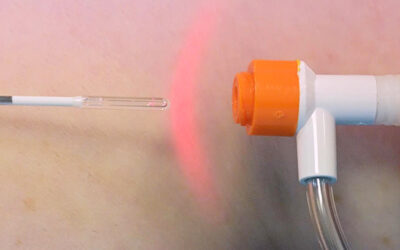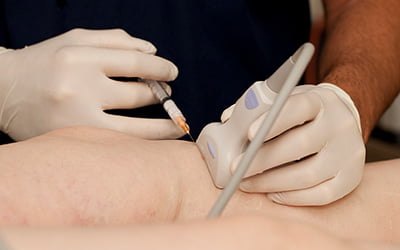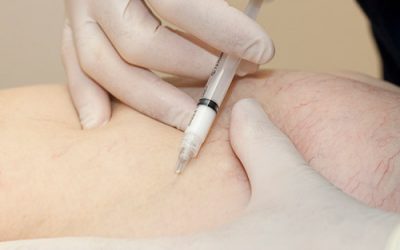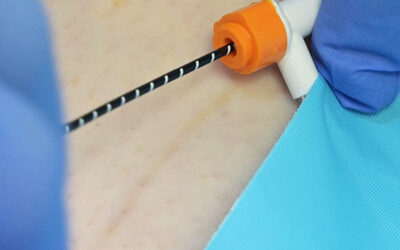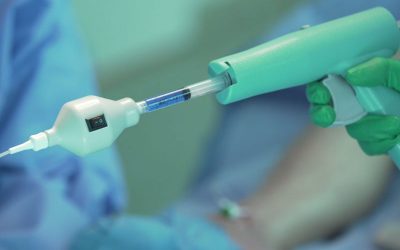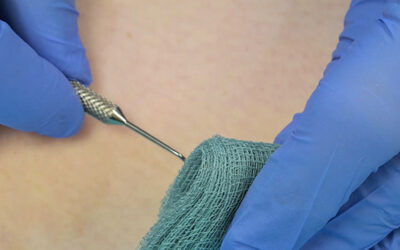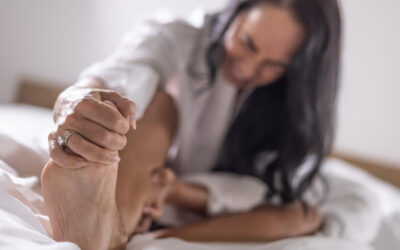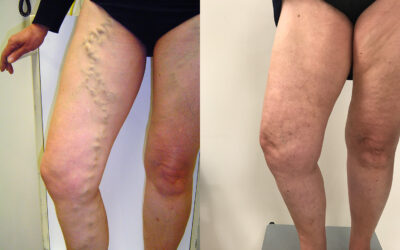Varicose Veins Treatment
Vein Health provides comprehensive approach to varicose veins treatment, bringing together the latest and most effective non-surgical techniques. Effectively treating varicose veins, spider veins, and leg ulcers, without the pain and scarring side effects of traditional surgery.
Varicose veins can be treated without having to undergo an invasive operation under general anaesthetic. There are a number of highly effective, non-invasive treatment options, designed to have you in-and-out of treatment relatively quickly. Permanently resolving the cause, signs and symptoms of your varicose veins.
Depending on the severity, varicose veins can be treated using: Sclerotherapy, Ultrasound Guided Sclerotherapy, Endovenous Laser Ablation (EVLA), Vein Glue, Radiofrequency Ablation, or Ambulatory Phlebectomy.
Varicose Veins Treatment Procedures
Endovenous Laser Ablation (EVLA)
Under ultrasound guidance, a laser fibre is placed into the abnormal vein through a tiny incision. When the laser is activated and the fibre is slowly removed, this produces a reaction in the vein wall along the treated section, resulting in collapse and sclerosis of the vein wall with minimal discomfort.
Ultrasound Guided Sclerotherapy
Ultrasound Guided Sclerotherapy is a highly specialised procedure involving injecting a sclerosant solution into the abnormal veins using ultrasound guidance, causing the vein wall to collapse. The veins dissolve and disappear as the body gradually absorbs them.
Sclerotherapy
The gold standard treatment of spider veins is sclerotherapy, also known as microsclerotherapy or direct vision sclerotherapy. It involves the injection of an irritating solution, through a tiny needle into the spider veins which causes them to close over and harden over.
Radiofrequency Ablation
Radiofrequency ablation (RFA) relies on thermal (heat based) damage to the vein, that leads to immediate closure of the vein. Once the vein is treated by radiofrequency ablation, it will gradually undergo complete absorption by the body and disappear over time.
VenaSeal (Vein Glue)
VenaSeal is a medical grade glue that is placed within the varicose vein using a small catheter, sealing the vein wall together in seconds. Over the coming hours, the treated vein will permanently harden over and eventually undergo absorption by the body over several months.
Ambulatory Phlebectomy
Ambulatory Phlebectomy is the surgical removal of visible varicose veins, through keyhole incision. The procedure eliminates varicose veins through a series of small punctures (as tiny as 1mm) made in the skin adjacent to the vein.
Why choose us?
Fast, easy vein treatment.
Walk-in, Walk-out.
Vein Clinics in Melbourne & Sydney
World-class
varicose vein treatment.
Comprehensive aftercare
and follow-up.
What to expect
Learn all about your first appointment, what's included, and how much it will cost.
Varicose Veins Treatment Questions
What if I do not treat my varicose veins?
Vein disease is progressive which if left untreated is likely to become worse with time. Increasing symptoms that can occur with untreated varicose veins include leg tiredness, heaviness, aching, throbbing, restlessness, tingling, itching, numbness, and swelling. More serious complications such as phlebitis, blood clots, dermatitis, and vein ulcers can develop if varicose veins are left untreated.
Do I need these veins?
Varicose veins and spider veins are not functional. Once veins become abnormal, our body finds alternative pathways with healthy veins to carry blood. You can never run out of veins. Varicose veins are not missed by the circulation. In fact, it improves without them.
Does it hurt to have varicose veins removed?
The amount of discomfort felt will vary with the individual. The needles used are extremely fine (similar to acupuncture needles) and many are hardly felt at all. The injected solution can sting slightly for short periods of time. If EVLA is used, then minimal discomfort is experienced as it is performed under local anaesthetic.
Are topical skin lasers an effective treatment for spider veins?
Despite the proven usefulness in the treatment of large varicose veins using EVLA, the treatment of leg veins by laser light to the skin has thus far been disappointing. Currently, available lasers can be very useful in treating the tiny cosmetic facial veins but have been significantly less effective on leg veins when compared to expert sclerotherapy. Also, topical laser therapy is far from painless.
What type of solution is injected into veins?
The current recommended and TGA-approved solutions used for sclerotherapy in Australia are referred to as “detergent sclerosants”. Sodium Tetradecyl Sulphate and Polidocanol are the 2 detergent sclerosants used widely across the world. Hypertonic saline (concentrated salt water) has limited use in the treatment of varicose veins. Dr Paraskevas will discuss these sclerotherapy solutions in greater detail at the initial visit.
How many treatments will I require?
Your treatment protocol, which includes the number of treatments required, will be determined at your first consultation.
Does the vein treatment interfere with my work or home duties?
This is a walk-in, walk-out procedure. Most treatments take about 30 minutes to perform. Following treatment, your daily routine should not be disrupted, normal duties can be resumed.
What should I expect after treatment?
Most patients will experience some mild discomfort after the procedure, but nothing that will interfere with your daily routine. It is important to follow the post-procedure instructions carefully, which include walking, wearing a compression stocking, and drinking plenty of water.
Can you tell me about exercise and my vein treatment?
It’s best to avoid heavy lifting and any strenuous activity for about 4-5 days after the treatment. This allows the body to recover after the procedure. It’s also important to walk 30 minutes a day.
When will my varicose veins heal?
Once treated, varicose veins can take many months to heal, varying from patient to patient. The good news is that relief from most symptoms comes quickly after treatment, generally within a few weeks.
Will the treated veins come back?
Treated correctly the veins will not come back, as the body has absorbed them. New veins, however, may appear with time. How quickly and how many appear, depends on whether you have inherited veins that are more likely to deteriorate. Other factors such as starting the pill, becoming pregnant, or occupations with prolonged standing, can affect the development of abnormal veins.
What are the possible complications if I do not have any treatments?
With large varicose veins, spontaneous blood clots may develop in the superficial veins and more rarely, the deep veins. Clots in the deep veins (deep vein thrombosis or DVT), can dislodge and travel to the lungs, which can cause pulmonary embolism, a life-threatening condition. Skin changes, including increased or decreased pigmentation, eczema of the skin (venous dermatitis), hardening of the skin and underlying fat (lipodermatosclerosis), and leg ulcers, may develop in the lower legs. Ulcers may become weepy, infected, and painful and take longer to heal.
What are the costs of treatment?
The expected cost for treatment varies between individuals and will be provided in writing following your assessment. Rebate is claimable through Medicare except for the smallest spider veins. In Australia, the Medicare Safety Net reimburses eligible patients once a threshold has been reached. Please ensure that you are registered as a family or couple for the Medicare Safety Net.
Forms can be provided at your initial consultation or are available online at Medicare Australia. All payments are to be made on the day of review/treatment, by cash, EFTPOS, credit card, or cheque. Diners cards are currently not accepted.
Does vein treatment require a stay in hospital?
No hospital admission is necessary for our leg vein treatments. Sclerotherapy, ultrasound guided sclerotherapy, endovenous laser ablation, VenaSeal vein glue, etc – all these procedures are performed in clinic.
Night Cramps and Varicose Veins: Is This Keeping You Awake?
Many people experience leg cramps and discomfort at night, but few realise these symptoms might be linked to an underlying venous condition.
Patient Case Study: 18 Years Varicose Vein-Free
One patient’s remarkable journey shows how modern treatment and dedicated follow-up care create lasting results.
Never Too Late: Varicose Vein Treatment for Seniors
Discover why it’s never too late to treat varicose veins & how modern options can make a difference in your comfort and wellbeing.

